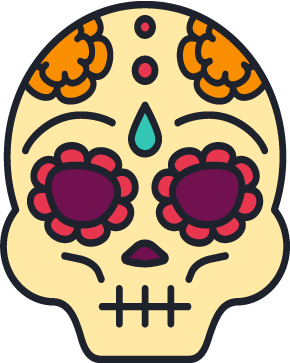- November 02, 2020
- By Sala Levin ’10
With its ubiquitous orange marigolds, fragrant incense, intricately designed papel picado (perforated tissue paper) and traditional mariachi music, the multisensory Día de los Muertos, or Day of the Dead, was ripe for Pixar’s adaptation in the 2017 movie “Coco.”
But the holiday, celebrated on Nov. 1 and 2 in Mexico and across Latin American and Caribbean countries to commemorate deceased loved ones and invite them to visit from the beyond, has nuances that can’t quite be conveyed in tear-jerking animated film.
“Even if you’re not religious, (the holiday) is so loved and it touches onto very intimate stuff—your loved ones, the people closest to you,” said Spanish doctoral candidate Nidia Mariana Reyes, a native of the northern state of Chihuahua in Mexico who presented on the holiday in an online program hosted last week by UMD’s Latinx Alumni Network.
The contemporary incarnation of Día de los Muertos is a blend of the religious and cultural traditions of Mexico’s native peoples and the Christian practices of Spanish conquistadors. Indigenous Mexican peoples believed in an underworld, a living world and a heaven that were connected through waterways and other points. During the Day of the Dead, celebrants use particular elements to create a threshold or portal that connects the worlds of the living and the dead.
Regional variations on the holiday abound in Mexico. People living in coastal regions may mark the day with seafood dishes and aquatic-themed altars, while those who live in tropical or sub-tropical areas may decorate with palm tree leaves. Here are some of the most common components of a typical Día de los Muertos celebration.
 Skulls
Skulls
On the Day of the Dead, skulls adorning people’s homes “create a sense of familiarity with the dead,” said Marco Polo Juarez Cruz, an art history Ph.D. student specializing in 20th-century Latin American and American art. “With that familiarity, we understand that everybody’s going to follow that destiny, that our presence here has a limit.”
Before Spanish conquest, native people often kept skulls of warriors on ritual altars. When the conquistadors came, “they didn’t accept or support those practices, but in order to convert the natives to their religious beliefs, Catholicism, they incorporated the tradition, but gave it a little twist,” said Reyes. They began making skulls out of alfeñique, a confection made of sugar, egg whites, lemon and chautle, a kind of cactus. Today, sugar skulls are a standard part of the Day of the Dead, along with skulls made of chocolate and other sweets.
 Candles, Papel picado and Dogs
Candles, Papel picado and Dogs
Candles are always found on ofrendas, helping to guide the deceased along the path toward their living loved ones. People also might burn incense to purify their homes “so no bad spirits are allowed—just the people you’re calling,” said Reyes. Papel picado, tissue paper chains with designs cut into them, come in a range of colors and symbolize life’s fragility; the holes are also thought to allow spirits through. Toy dogs are often seen on ofrendas, or altars, a reference to the indigenous belief that spirits were led across the river to the underworld by a breed of hairless dog called xoloitzcuintle. The dog is believed to be especially important in helping to bring deceased children back to their families on the Day of the Dead.
 Marigolds
Marigolds
The bright color and smell of marigolds are believed to help keep the deceased on the path toward their friends and relatives.
 Salt and Water
Salt and Water
A small spoonful of salt purifies the body, while water refreshes. (If the deceased had a preferred tequila, rum, wine or other tipple, the polite thing to do is offer that, too.)
 Pan de Muerto and Other Foods
Pan de Muerto and Other Foods
The sweet bread called pan de muerto (meaning “bread of the dead”) is generally made with anise seed and a little orange zest. More traditional Catholics consider the bread to represent the body of Christ, while others see it as an offering to the deceased. The bread may be decorated with a baked tear drop or bones. Some celebrants cook labor-intensive foods, befitting a special day; Juarez Cruz said his mother often makes tamales or mole on Día de los Muertos. Any foods that were particular favorites of the deceased are also placed on the ofrenda; Reyes had a young cousin who loved chips and Coca-Cola, so those are always on the altar in her family. The food is usually shared with friends and neighbors, making the day a communal event.
 Photographs and Other Knickknacks
Photographs and Other Knickknacks
Pictures of late relatives are traditionally found on ofrendas, as do other mementos of the deceased. Reyes’ family always puts her grandfather’s glasses and favorite book on their altar, along with a toy owl, an animal he loved. In honor of her uncle, a musician, the family places a guitar at the ofrenda.
The essence of the holiday, said Reyes, is to make sure the dead don’t get so lost in the next world that they lose their place here. “Part of the tradition is to talk about and remember the dead,” she said. “Not just to keep the tradition going, but also
Topics
Arts & Culture